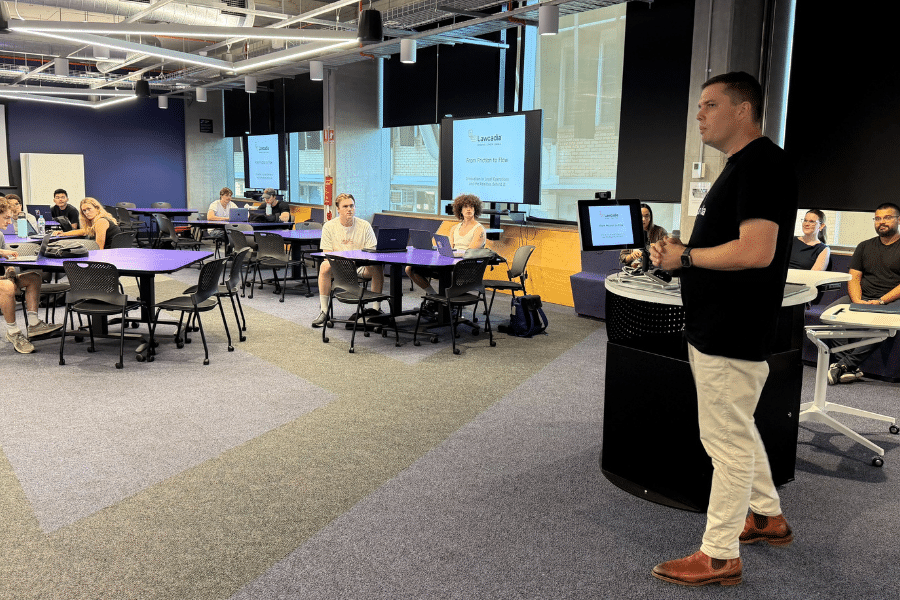Innovation in legal technology is often associated with rapid advances in automation and AI. Yet, as Steven Dudley, Head of Client Solutions at Lawcadia, told students during a recent guest lecture at the University of Queensland’s Technology and Innovation Management course, true innovation begins with people.
“We build technology to improve people’s lives by improving how they work.”
Innovation that starts with real problems
The legal industry has long been characterised by tradition, process, and precedent. While these values bring rigour, they can also make change slow. Steven shared that the most effective innovations in legal operations don’t come from chasing new features but from understanding the real problems that lawyers face every day.
“In-house legal teams are often small; maybe 10 lawyers supporting a company of 1,000 people. They’re under pressure, juggling competing priorities and managing growing workloads. The right technology should make their work easier, not add another layer of complexity.”
Lawcadia’s approach has always been to identify friction points first – whether in collaboration, workflow, or reporting – and then design technology that removes barriers and restores focus to meaningful work.
Human-centred by design
At the heart of Lawcadia’s innovation strategy is a commitment to human-centred design. Lawyers don’t want to spend hours learning a new system; they want tools that feel intuitive and support the way they already think and work.
“If it’s not easy, people won’t use it. Simplicity matters,” Steven explained. “We design specifically for lawyers: super simple, but not dumbed down.”
This philosophy led to the development of Lawcadia’s no- and low-code workflow engine, enabling legal teams to configure processes themselves without relying on IT support or developers. It’s an approach that empowers users to experiment, iterate, and scale innovation within their own departments.
Aligning data with insights and outcomes
Innovation is not just about efficiency; it’s also about visibility and value. For General Counsel, proving impact requires evidence such as metrics that demonstrate how the legal team contributes to the organisation.
“Executives need to see value. We start with the end in mind: what will you need to report in six or twelve months to secure more resources or justify headcount?”
That means capturing the right data now so it can be translated into insights later; metrics such as cost avoidance, internal versus external work ratios, and cycle times. When innovation is tied to measurable outcomes, it becomes sustainable and strategic.
Overcoming resistance and enabling change
One of the biggest challenges in legal transformation is change resistance. Many lawyers are time-poor and risk-averse, and IT teams can be protective of internal systems. Lawcadia addresses this by helping legal leaders anticipate objections and guide internal discussions.
“We focus on ‘what’s in it for me?’,” Steven said. “For example, if everything’s in the system, your holiday handover takes minutes instead of a day.”
By equipping clients with security documentation, implementation guidance, and return-on-investment models, Lawcadia supports General Counsel in navigating organisational and IT concerns. This makes makes innovation not just possible but practical and achievable.
Building for flexibility and security
Innovation in legal tech must balance agility with governance. Lawcadia’s two-sided architecture was designed to securely connect in-house counsel with external law firms, supporting collaboration while maintaining data sovereignty and compliance.
“A substantial portion of our operating costs now go to compliance,” Steven noted. “Security is fundamental.”
This foundation allows clients, including banks and large corporates, to innovate with confidence, knowing that flexibility and security can coexist.
A thoughtful approach to AI
Artificial intelligence continues to dominate conversations in legal technology, but at Lawcadia, the approach is grounded in practicality and purpose rather than hype.
“AI can be transformative, but it needs to be applied in ways that genuinely help lawyers work more efficiently and effectively,” Steven said.
Rather than viewing AI as a replacement for human judgement, Lawcadia sees it as an enhancement tool – something that can streamline repetitive tasks, assist with workflow design, and accelerate the delivery of value without compromising quality or security.
“Our goal is to make technology smarter, not to make people redundant. The human element – empathy, reasoning, and context – remains central to how legal teams operate and how we support them.”
This measured approach ensures that innovation remains aligned with client needs, allowing AI to amplify human capability while maintaining the trust, control, and accountability essential in legal work.
Lessons for innovation leaders
Steven concluded his lecture with practical advice for future innovators:
- Love the problems: Passion and curiosity lead to better solutions.
- Understand the business: Innovation succeeds when it speaks the language of value.
- Keep iterating: There’s no final version – every design is a step toward the next improvement.
- Communicate effectively. Explain value in business terms, not technical jargon, and handle resistance with empathy — using approaches like Feel–Felt–Found to acknowledge concerns, share perspective, and build confidence.
For Lawcadia, this mindset underpins every product decision. The goal is to create technology that enables people to work smarter, collaborate effectively, and deliver measurable value across their organisation. Each innovation is guided by clarity of purpose and a commitment to improving how legal teams operate and succeed.

